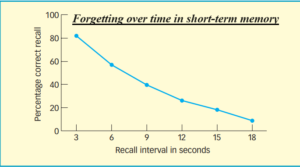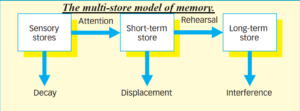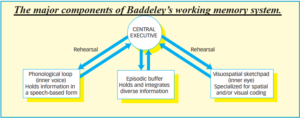Enlighten Knowledge; The science of human memories (1).

Introduction
Imagine for a moment what it would be like to have no memory.
You wouldn’t recognize anyone or anything as familiar.
You wouldn’t be able to talk, read, or write because you would have no knowledge of language.
You would have a very limited personality, because you would know nothing about the events of your own life, and would therefore have no sense of self.
The devastating effects associated with the progressive destruction of the human memory system can be seen in patients suffering from Alzheimer’s disease.
The long and the short of memory
- Short-term memory has a capacity of between 4 and 7 chunks of information, and information in short-term memory is held for up to about 18 seconds.
- Some brain-damaged patients have intact short-term memory but impaired long-term memory, and others have the opposite pattern.
- It was assumed incorrectly within the multi-store model that there is only a single short-term store and a single long-term store.
- Baddeley’s basic working memory model consists of three components: central executive; phonological loop; and visuospatial sketchpad. The sketchpad seems to consist of fairly separate components specialized for visual and spatial processing.


Working memory
- Working memory is used when we need to combine processing and short-storage functions.
- The basic working memory model of Baddeley and Hitch consists of a central executive, a phonological loop, and a visuospatial sketchpad.
- The phonological loop has a phonological store and an articulatory control process.
- The visuospatial sketchpad has somewhat separate visual and spatial sub-systems.
- The central executive is attention-like. It is used for various functions, probably including inhibition, shifting, and updating.

All three components of the basic working memory system have limited capacity.
However, each component can function relatively independently of the others.
These assumptions permit us to make two crucial predictions concerning whether two tasks can be performed successfully at the same time:
- If two tasks require the same component of working memory, they can’t be performed successfully together, because that component’s limited capacity will be exceeded.
- If two tasks require different components, it should be possible to perform them as well together as separately.
Long-term memory.
This helps to explain mood-state-dependent memory and the typical superiority of recognition over recall.
- According to consolidation theory, recently formed memories at an early stage of consolidation are especially vulnerable to interference and forgetting. This explains why the rate of forgetting is most rapid shortly after learning.
- Mood-state-dependent memory:
The finding that memory is better when the mood state at retrieval is the same as that at learning than it is when the two mood states differ. - Consolidation:
A process mostly completed within several hours, but which can last for years, which fixes information in long-term memory.
Types of long-term memory
- Amnesic patients have problems with explicit memory (involving conscious recollection) but not with implicit memory (not involving conscious recollection).
- All amnesic patients have impaired ability to form new episodic memories. However, impairments of the ability to acquire new semantic memories (general knowledge) are less widespread.
- Episodic memory:
A form of long-term memory concerned with personal experiences or episodes that happened in a given place at a specific time; see semantic memory. - Semantic memory:
A form of long-term memory consisting of general knowledge about the world, language, and so on; see episodic memory. - Declarative memory:
A form of long-term memory concerned with knowing that something is the case; it includes episodic memory and semantic memory.
Forgetting
Our ability to remember information and the events of our own lives is of tremendous importance.
In the absence of memory, we would be in a similar position to a newborn infant, with everything seeming to be completely novel and surprising.
It is useful to consider the factors leading to forgetting so we can minimize the amount of information we forget.
- Numerous adults claim to have recovered repressed memories of sexual and/or physical abuse suffered in childhood. However, there is much controversy concerning the genuineness of these claims.
-
Infantile amnesia:
The inability of adults to recall autobiographical memories from early childhood.
-
Reminiscence bump:
The tendency of older people to recall a disproportionate number of autobiographical memories from the years of adolescence and early adulthood.
- Much forgetting is a result of retroactive interference (later learning disrupting memory for earlier learning) and of proactive interference (previous learning disrupting later learning and memory).
- According to the encoding specificity principle, we are most likely to remember something when the information available at the time of retrieval matches the information stored in.
-
Repression:
Motivated forgetting of traumatic or other very threatening events.
-
Proactive interference:
Disruption of memory by previous learning, often of similar material; see retroactive interference.
-
Retroactive interference:
Disruption of memory by learning of other material during the retention interval; see proactive interference.
-
Encoding specificity principle:
The notion that retrieval depends on the overlap between the information available at retrieval and the information within the memory trace.
Everyday memory
- When elderly people recall personal memories to cues, a disproportionate number come from the years of adolescence and early adulthood. This occurs in part because this is a period of life characterized by memorable novel experiences.
- The autobiographical memory base contains personal information about lifetime periods, general events, and event-specific knowledge.
- Our autobiographical memories are influenced by our major goals.
- Many of the inaccuracies of eyewitness testimony are a result of misleading post- event information and others may be because of weapon focus.
- Eyewitnesses’ confidence in the accuracy of their memory often fails to predict the actual accuracy.
- Fewer errors are made on identification parades when eyewitnesses are warned that the culprit may not be present, or the line-up is sequential rather than simultaneous.
Follow the link below to join our WhatsApp platform for more updates
https://chat.whatsapp.com/Bt7QvtyljSPHCa7y17zLYP
You may also like to read
Major approaches to human cognition and techniques used to study the brain
fixed mindsets and growth mindset pros and cons on life styles
Strategies that promote cooperative teaching and learning and how to apply them in the class





